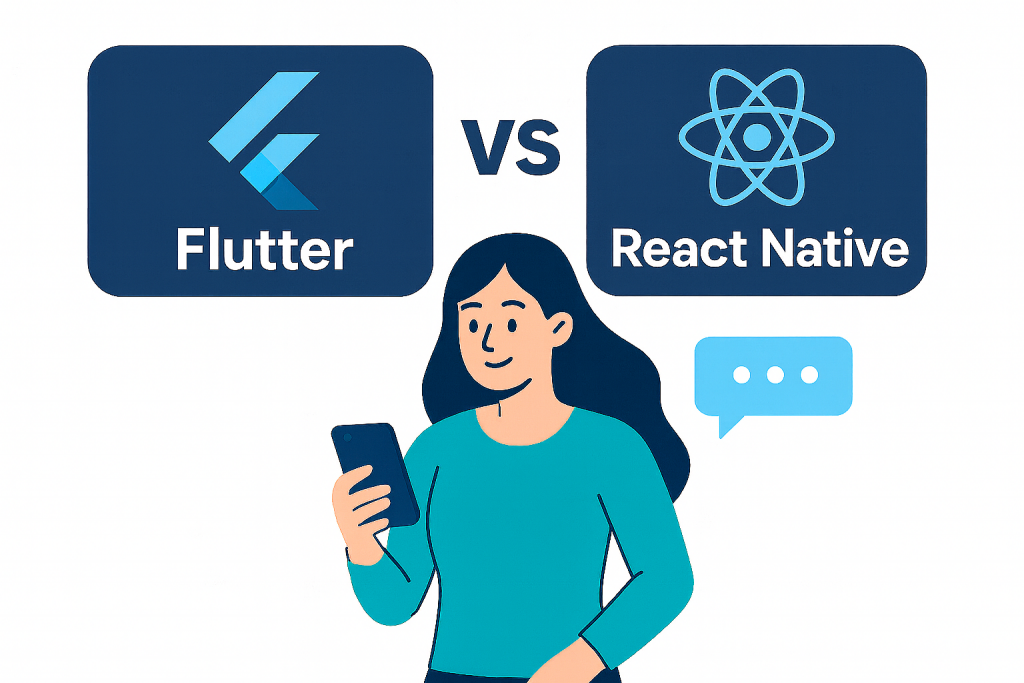
Building a chat app today is easier than ever – but choosing the right framework can significantly affect how fast the app loads, how smooth it feels, and its overall performance.
Two of the most popular cross-platform frameworks today are Flutter and React Native. Both allow developers to build Android and iOS apps using a single codebase, but each comes with its own strengths, weaknesses and ideal use cases.
So, which one is the better fit for your chat application?
Let’s break down the key differences to help you make a confident choice.
What makes Chat Apps special
Chat apps are not just about sending messages. They require:
- real-time updates (messages, typing indicators, read receipts),
- offline support,
- fast and responsive UI,
- and smooth multimedia handling (images, voice notes, video calls).
That’s why choosing the right framework isn’t just about syntax – it’s about performance, ecosystem, and scalability.
Flutter: Google’s vision for consistency
Flutter created by Google, uses the Dart programming language and comes with its own rendering engine. Everything – from UI components to rendering – is controlled by Flutter itself, ensuring predictable results across platforms.
🔹 Pros:
- Consistent design: your chat bubbles, message lists, and animations look identical across iOS and Android.
- Fast performance: compiled to native code, so scrolling through long message lists feels smooth.
- Rich animations: ideal if you want a sleek, modern chat UI with transitions, reactions, and effects.
- Great documentation: clear guides and examples that make development straightforward.
🔸 Cons:
- Dart is less familiar for most developers
- App size tends to be larger
- Fewer ready-made plugins for real-time features compared to React Native.
React Native: Facebook’s JavaScript powerhouse
React Native maintained by Meta (Facebook), uses JavaScript or TypeScript and leverages React principles – making it a natural fit for web developers.
🔹 Pros:
- Mature ecosystem: tons of community packages and ready integrations for chat SDKs.
- Familiar syntax for JavaScript/React developers.
- Hot Reload and strong debugging tools speed up development.
🔸 Cons:
- UI can look slightly different on iOS vs Android due to reliance on native components.
- Performance may dip slightly on animation-heavy screens compared to Flutter.
Performance
For chat apps, real-time performance is crucial – messages, typing indicators, and presence updates should appear instantly.
Flutter:
Flutter apps compile to native ARM code, which gives them excellent performance and smooth animations. This makes Flutter slightly better for chat apps that need seamless transitions or complex UI animations (like message bubbles, reactions, or image previews).
React Native:
React Native’s performance is strong but relies on a JavaScript bridge to communicate with native modules. While this is rarely noticeable in everyday chat interactions, Flutter tends to handle heavier UI loads more efficiently. And complex animations may need optimization.
✅ In short: Flutter wins slightly for raw performance.
UI and design consistency
A chat app needs to look and feel the same across devices – text bubbles, avatars, timestamps, and chat lists must be consistent.
Flutter:
Flutter shines here. Its widget-based approach ensures the UI looks identical on Android and iOS without extra tweaking. You have total control over every pixel.
React Native:
React Native uses native components, which means slight design differences between Android and iOS. You may need additional adjustments to keep the UI uniform.
✅ In short: Flutter wins for pixel-perfect design consistency.
Real-Time Chat features and SDK integration
This is a big one.
A chat app requires sockets, message persistence, push notifications, and sometimes audio/video calling.
React Native – offers broader support from real-time SDKs.
Flutter – is catching up quickly, and for example, both the ConnectyCube React Native SDK and ConnectyCube Flutter SDK can now be integrated in minutes with ready-to-use methods for chat, push notifications and calls.
Both frameworks work great but React Native may still provide a slightly smoother start when it comes to third-party integrations, as many SDKs offer React Native wrappers or built-in support out of the box.
Development speed and ecosystem
React Native:
If your team already uses JavaScript or React for web, React Native offers a very gentle learning curve. Its ecosystem is mature, with many ready-to-use libraries for chat features, push notifications, and media handling.
Flutter:
Flutter’s development is fast, too, especially with Hot Reload and a consistent UI across platforms. However, the Dart ecosystem is smaller, and you may find fewer third-party packages for chat-related needs compared to React Native.
✅ In short: React Native wins for ecosystem and developer familiarity.
Community and long-term support
Both frameworks are backed by tech giants:
- Flutter by Google
- React Native by Meta
Both receive regular updates.
React Native has been around longer and powers apps like Instagram, Discord, and Shopify.
Flutter is newer but rapidly growing, with strong Google backing and enterprise adoption.
✅ In short: React Native has a larger ecosystem today, but Flutter is quickly closing the gap.
So… Which should you choose?
Choose Flutter if you want:
✅ A highly polished, consistent UI
✅ Custom animations & visually rich chat layouts
✅ Predictable cross-platform behavior
Choose React Native if you want:
✅ Faster development with JavaScript
✅ A larger developer community
✅ Easy integration with existing native modules
Final thoughts
Both Flutter and React Native are excellent choices for building a chat app. The best framework ultimately depends on your team’s skill set, UI requirements and long-term goals.
Choose Flutter if performance and visual consistency are your top priorities.
Choose React Native if you prefer a mature ecosystem and easier third-party integrations.
In short: Flutter delivers polished visuals, while React Native offers greater flexibility.
Whichever framework you choose, ConnectyCube ensures you don’t need to build everything from scratch. It provides all the essential features a chat app needs, so you can focus on your product’s unique value instead of backend complexity.
Build faster. Chat smarter. Pick the stack that matches your vision – and let ConnectyCube handle the rest. 💬
🔗 Useful links
ConnectyCube Flutter SDK Getting Started
ConnectyCube Flutter Chat API documentation
ConnectyCube React Native SDK Getting Started
ConnectyCube React Native Chat API documentation
Join the ConnectyCube Discord сommunity for quick answers and expert tips.

